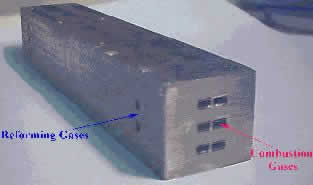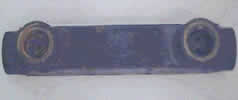|
Catalytic
Plate Reactors
Supplying heat directly into an endothermic reaction, rather than
via inter-stage heaters or by radiation to a packed tube is a vital
key to intensifying many important chemical processes. The catalytic
plate reactor (CPR) offers an attractive route for achieving this.
In a CPR, metal plates coated with a suitable catalyst are arranged
in such a manner that exothermic and endothermic reactions take
place in alternate channels (Fig. 1.). These channels typically
have a height of order of millimetres and a catalyst thickness of
the order of microns.
|
 |
Fig 1. A pair of adjacent channels in the catalytic plate reactor
The research work at the Process Intensification
Group of Newcastle University has focused on the development
of a detailed theoretical study on CPR's with the aim of providing
a base line for a general design procedure. The advantages of CPR
designs over conventional reactors arise due to excellent heat transfer
characteristics and minimal intra-catalyst diffusion resistance.
The heat transfer mechanism within a CPR is via conduction through
the plates separating alternate process channels and as such is
largely independent of the process gas superficial velocity. The
catalyst layers within a CPR are thin which results in minimal diffusion
limitations and thus high catalyst utilisation. These advantages
result in reactors which are smaller, lighter and with a small associated
pressure drop than conventional alternatives. The potential saving
in reactor volume can be seen in Table 1, below:
Table 1. Size Reduction Through CPR Utilisation.
|
Reaction |
Current Technology |
Size Reduction Factor |
|
Steam Reforming |
Packed Tubes in Furnace |
|
|
Fischer Tropsch Synthesis |
Slurry Bed Reactor |
|
Catalytic Steam Reformer
The feasibility of the concept of coupled endo and exothermic reactions
has been demonstrated using steam reforming of methane as the fast
and highly endothermic reaction with the energy being provided by
the catalytic oxidation of methane. Potential exploitation of this
system includes on-board hydrogen production for fuel cell powered
vehicles, which are of particular interest due to stringent legislation
for the control of automobile exhaust gases. This is possible due
to the significant size reduction (see Table 1.). Another important
application is the production of syngas, which is the feed-stock
for many industrial processes. Methods for preparing and coating
the catalysts (based on sol-gel technology) have been developed
and the necessary activity to achieve a targeted heat flux of 10kW/m2
demonstrated.
The replacement of the homogeneous combustion used in conventional
reactors by the catalytic one brings several advantages. It proceeds
at lower temperature than conventional combustion, posing fewer
constraints for materials of construction and producing virtually
no NOx . Since it is a flameless process, long radiation paths needed
in conventional fired furnaces are replaced by channel dimensions
of one or two mm, with an obvious impact on reactor size.
|
 |
Fig. 2. Design of simple CPR by using stacked diffusion bonded
shims
(manufactured by Chart Exchangers)
An example of the reactor design where methane combustion and reforming
are integrated is shown in Fig. 2. The device used in experimental
work is shown in Figure 3. These devices are produced from patterned
metal shims which are stacked together and diffusion bonded yielding
a compact metal block.
|
 |
Fig. 3. Bench-scale CPR for methane steam reforming
An additional important benefit of this concept is that the production
scaling can be handled through replication rather than re-sizing.
This leaves the reactor performance effectively the same at all
scales, thus reducing the time requirement from development to commercial
production.
Methane Reforming in a Catalytic Plate Reactors
The potential of the CPR for dry or mixed reforming is currently
being investigated. In the process methane, steam and carbon dioxide
are simultaneously passed over a nickel based catalyst. The technique
has been shown to strongly influence both the the CO:H2 ratio and
rate of carbon laydown. A parametric study is underway in an effort
to minimise coke deposition whilst producing a CO/H2 ratio which
is suitable as a feedstock for Methanol or Fischer Tropsch processes.
Fischer-Tropsch synthesis in a CPR
A second application of the CPR is product enhancement for catalytic
reactions where the product spectrum is highly dependant upon catalyst
temperature. In such an application alternate channels contain a
boiling heat transfer fluid to maintain an isothermal catalyst temperature.
To demonstrate the concept the Fischer-Tropsch (FT) reaction has
been investigated.
The hydrocarbon product spectrum produced by a FT catalyst is
highly dependant upon catalyst temperature and rate of diffusion
of reactants into the catalyst matrix. The reaction is highly exothermic
and if rates of heat removal from the catalyst are not sufficiently
high "hot-spots" will form which will result in degradation
of the product spectrum. Studies have revealed that thin catalyst
coats attached to heat transfer surface areas within a CPR can greatly
enhance the yield of desirable products per unit volume as compared
to conventional fixed bed technology. This volume saving coupled
with an overall lighter design, requiring less ancillary equipment
and with a low pressure drop make the FT CPR a potential reactor
for the recovery of stranded gas reserves.
Contact details
Email:
Dr Jon Lee
|